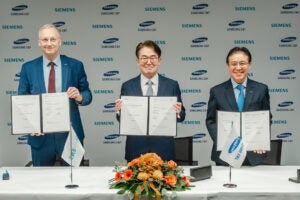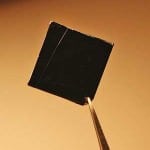Perovskite solar cells are a high-efficiency, low-cost alternative to traditional silicon-based solar panels. With the perovskite solar cell industry expected to reach $1.2 billion by 2033, there’s enormous potential for this next-generation technology.
The Basics of Perovskites
Perovskites are a type of material, with a distinctive crystal structure described as ABX3 (Figure 1). These crystals occur naturally in the form of calcium titanate, but this mineral has few practical uses.

Replicating this structure with specific combinations of organic and inorganic materials can create a perovskite semiconductor. These synthetic perovskites, depending on the atoms in the structure, have an impressive array of interesting properties. Certain perovskites are excellent at absorbing sunlight and converting it into electrical energy, and this is what they are known for in the solar industry.
Perovskites vs. Silicon
In some ways, perovskites are even better at absorbing sunlight than silicon, which currently dominates 95% of the commercial solar panel market. What makes perovskites particularly exciting for researchers is the rapid advancement in their solar cell efficiency. Since 2009, the maximum efficiency of perovskite solar cells has risen from 3.9% to 30.1%—it took 37 years for crystalline silicon solar cells to achieve comparable efficiencies.
While silicon is currently the standard, it is not an ideal solar material, as it has an indirect bandgap. You cannot significantly change its material properties, so the only solution is to use a relatively thick layer of silicon, making sure as much light as possible is absorbed. This means silicon solar panels are traditionally large, rigid, and heavy. On the other hand, researchers can tune the properties of perovskites to have an optimal bandgap for sunlight absorbance. With careful material selection and device engineering, perovskites can efficiently absorb sunlight even when coated in very thin layers, often below micrometer-level thicknesses. With these thin layers, perovskite solar cells are lightweight, can be made on flexible substrates, and can even be used in semi-transparent solar panels.
In their production, perovskite solar cells can be entirely solution processed. This means that they can be made with scalable methods like slot-die coating (Figure 2) and ink jet printing. These techniques are much cheaper and produce less waste than the processing of silicon. Large-scale perovskite solar cells have the potential to be cost-effective compared to the dominant silicon solar technology.

Challenges of Perovskites
Despite their promise, as solar materials, perovskites are still presented with some key challenges. Most notably, they are susceptible to degradation when exposed to moisture, heat, and light—all necessary factors for solar panels to do their job.
Moisture. Humidity can cause rapid degradation of perovskite films, especially those including methylammonium iodide. The organic components in the perovskite are very hygroscopic. When water molecules interact with these components, they form weak hydrogen bonds that compromise the structural stability of the crystal. At first, these changes are reversible, but with enough moisture penetration, the perovskite crystal irreversibly decomposes. This breakdown can set off a chain reaction that creates more water, worsening the degradation.
Illumination. While light is obviously essential for solar cells to function, it can also contribute to degradation. Constant exposure to light can speed up chemical reactions and ion movement within the material. In mixed halide perovskites, light can cause different halide components to separate, which reduces voltage and efficiency. The effect of ultraviolet (UV) light on perovskite solar cell stability is most significant when combined with other environmental factors.
Temperature. Exposure to high temperatures can lower the efficiency of solar cells by affecting their internal properties. In perovskites, heat can increase defect formation and accelerate unwanted chemical reactions. Compared to silicon solar cells (which lose about 0.5% efficiency per degree Celsius increase), perovskite cells are even more sensitive to heat, making temperature management crucial during both fabrication and operation.
Other Hazards. The presence of lead in perovskite compounds is also problematic. Though it is used in much smaller quantities than those currently present in either lead- or cadmium-based batteries, concerns still remain about toxic lead compounds entering the environment. Within research there is disagreement about how much of an issue this will be for commercial perovskite solar panels. Some studies have suggested large-scale implementation of perovskites would require complete containment of degradation products. In contrast, other lifecycle assessments have found the toxicity impact of lead to be negligible in comparison to other materials used in the cell.
Next Steps for Perovskites
Although perovskite solar cells have reached impressively high efficiencies, these results are typically achieved in controlled lab environments. To push perovskites out of the lab, academic and industrial researchers are working hard to find perovskites with better intrinsic stability; improve encapsulation techniques (Figure 3), which protect the solar cells from environmental factors; and develop trial additives that improve perovskite stability.

One of the most effective strategies has been adjusting the materials used in the perovskite structure. For example, mixing different cations has helped to boost both stability and efficiency. In fact, the first perovskite cells to surpass 20% efficiency used a mixed organic cation system, and today’s top-performing devices often include inorganic components.
Researchers have also had success with new surface passivation techniques, which improve charge transfer at the perovskite surface. For example, 2D perovskites, which are designed to form 2D sheets rather than a bulk crystal structure, tend to be more stable than 3D perovskites, but they perform less efficiently. Combining them with 3D perovskites helps maximize both performance and longevity. A recent study using these cutting-edge passivation techniques showed perovskite solar cells can last beyond 4,500 hours under normal working conditions with minimal performance loss, and with less than 5% efficiency drop under a 1,050-hour damp heat test—important milestones toward commercial viability.
One exciting application within reach is perovskites in tandem solar cells. In September 2024, Oxford PV announced the first commercial sale of a perovskite-on-silicon solar panel. By stacking multiple solar materials, a tandem solar cell can capture more of the solar spectrum and achieve higher efficiencies than a single layer. The bandgap of a perovskite can be easily tuned by changing the perovskite composition, meaning that it can be paired with other solar materials, such as silicon. Perovskites can more efficiently use smaller wavelengths of the sun’s spectrum, so the efficiency of a silicon solar cell can be improved by depositing a perovskite solar cell on top. Perovskite-silicon tandem devices have achieved efficiencies of up to 31.3%, which is significantly higher than either crystalline silicon or perovskite solar cells individually.
Why Perovskites Matter?
Solar power is a cornerstone of the global shift toward renewable energy, which itself is an essential strategy for combating climate change and improving energy access. However, the limitations of traditional silicon-based solar panels can restrict their use in more innovative or complex applications. To expand the potential of solar energy, alternative materials must be explored. Perovskites, despite some unresolved challenges, offer significant promise. Their remarkable properties, coupled with low-cost and scalable manufacturing methods, could make solar panels more affordable, widely accessible, and more versatile.
—Imogen Pass is scientific content collaborator at Ossila. She writes articles that make science accessible with the knowledge and help of Ossila’s academic and industry experts. Ossila specializes in lab equipment and materials that are used in solar cell and display technology research, driving the development of higher efficiency solar panels, flexible organic light-emitting diode (OLED) screens, wearable solar-powered devices, battery technologies, and more.










